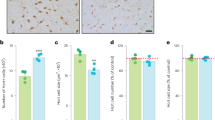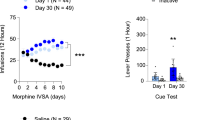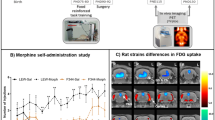Abstract
Recent studies have found that acute morphine administration increases serotonin (5-HT) transmission within the nucleus accumbens and other forebrain regions. In contrast, 5-HT transmission is depressed during withdrawal from chronic morphine. We show that pharmacological agents that increase brain 5-HT levels (fluoxetine or 5-hydoxytryptophan, 5-HTP) abolish the preference of chronically morphine-treated, withdrawn rats for a morphine-associated environment. Similar results were seen when fluoxetine was microinjected into the nucleus accumbens. Conversely, rats given morphine acutely showed an enhanced preference for a morphine-associated environment when pretreated with these agents. Fluoxetine also decreased the heightened anxiety found in morphine withdrawn rats. The results of our study indicate that drugs that augment 5-HT levels may reduce the desire for morphine during withdrawal.
Similar content being viewed by others
Log in or create a free account to read this content
Gain free access to this article, as well as selected content from this journal and more on nature.com
or
References
Acquas E, Carboni E, Di Chiara G . (1991): Profound depression of mesolimbic dopamine release after morphine withdrawal in dependent rats. European Journal of Pharmacology 193: 133–134
Ahtee L . (1980): Chronic morphine administration decreases 5-hydroxytryptamine and 5-hydroxyindoleacetic acid content in the brain of rats. Medical Biology 58: 38–44
Antkiewicz-Michaluk L, Romanska I, Vetulani J . (1995): Immediate and “day-after” effects of morphine on dopamine and serotonin metabolism in various structures of the rat brain. Polish Journal of Pharmacology 47: 355–358
Bardo MT, Rowlett JK, Harris MJ . (1995): Conditioned place preference using opiate and stimulant drugs: a meta-analysis. Neuroscience Biobehavioral Reviews 19: 39–51
Bedard P, Pycock CJ . (1977): ‘Wet-dog’ shake behavior in the rat: a possible quantitative model of central 5-hydroxytryptamine activity. Neuropharmacology 16: 663–670
Benloucif S, Keegan MJ, Galloway MP . (1993): Serotonin-facilitated dopamine release in vivo: pharmacological characterization. Journal of Pharmacology and Experimental Therapeutics 265: 373–377
Bloom FE, Hoffer BJ, Siggins GR, Barker JL, Nicoll RA . (1972): Effects of serotonin on central neurons: microiontophoretic administration. Federal Proceedings 31: 97–106
Bozarth MA, Wise RA . (1981): Heroin reward is dependent on a dopaminergic substrate. Life Sciences 29: 1881–1886
Boadle-Biber MC, Johannessen JN, Narasimhachari N, Phan T-H . (1987): Activation of cortical tryptophan hydroxylase by acute morphine treatment: blockade by 6-hydroxydopamine. European Journal of Pharmacology 139: 193–204
Bonci A, Williams JT . (1997): Increased probability of GABA release during withdrawal from morphine. Journal of Neuroscience 17: 796–803
Childress AR, Ehrman R, McLellan AT, MacRae J, Natale M, O'Brien CP . (1994): Can induced moods trigger drug-related responses in opiate abuse patients. Journal of Substance Abuse Treatment 11: 17–23
Clark RN, Ashby CR Jr, Dewey SL, Ramachandran PV, Strecker RE . (1996): Effect of acute and chronic fluoxetine on extracellular dopamine levels in the caudate-putamen and nucleus accumbens of rat. Synapse 23: 125–131
Contarino A, Zanotti A, Drago F, Natolino F, Lipartiti M, Giusti P . (1997): Conditioned place preference: no tolerance to the rewarding properties of morphine. Naunyn Schmiedebergs Archives of Pharmacology 355: 589–594
Danos P, Kasper S, Grunwald F, Klemm E, Krappel C, Broich K, Hoflich G, Overbeck B, Biersack HJ, Moller HJ . (1998): Pathological regional cerebral blood flow in opiate-dependent patients during withdrawal: a HMPAO-SPECT study. Neuropsychobiology 37: 194–199
Darmani NA, Shaddy J, Elder EL . (1997): Prolonged deficits in presynaptic serotonin function following withdrawal from chronic cocaine exposure as revealed by 5-HTP-induced head-twitch response in mice. Journal of Neural Transmission 104: 1229–1247
Dolberg OT, Iancu I, Sasson Y, Zohar J . (1996): The pathogenesis and treatment of obsessive-compulsive disorder. Clinical Neuropharmacology 19: 129–147
Dworkin S, Guerin GF, Goeders NE, Smith JE . (1988): Kainic acid lesions of the nucleus accumbens selectively attenuate morphine self-administration. Pharmacology, Biochemistry & Behavior 29: 175–181
Ehrman RN, Robbins SJ, Childress AR, O'Brien CP . (1992): Conditioned responses to cocaine-related stimuli in cocaine abuse patients. Psychopharmacology 107: 523–529
Ettenberg A, Pettit HO, Bloom FE, Koob GF . (1982): Heroin and cocaine intravenous self-administration in rats: mediation by separate neural systems. Psychopharmacology 78: 204–209
Fuller RW, Wong DT, Robertson DW . (1991): Fluoxetine, a selective inhibitor of serotonin uptake. Medical Research Reviews 11: 17–34
Garcia-Sevilla JA, Magnusson T, Carlsson A . (1980): Effects of enkephalins and two enzyme resistant analogues on monoamine synthesis and metabolism in rat brain. Naunyn Schmiedebergs Archives of Pharmacology 310: 211–218
Gerra G, Calbiani B, Zaimovic A, Sartori R, Ugolotti G, Ippolito L, Delsignore R, Rustichelli P, Fontanesi B . (1998): Regional cerebral blood flow and comorbid diagnosis in abstinent opioid addicts. Psychiatry Research 83: 117–126
Gerra G, Fertonani G, Zaimovic A, Rota-graziosi I, Avanzini P, Caccavari R, Delsignore R, Lucchini A . (1995): Hostility in heroin abusers subtypes: fluoxetine and naltrexone treatment. Progress in Neuropsychopharmacology and Biological Psychiatry 19: 1225–1237
Gerrits MA, Van Ree JM . (1996): Effect of nucleus accumbens dopamine depletion on motivational aspects involved in initiation of cocaine and heroin self-administration in rats. Brain Research 713: 114–124
Gobert A, Rivet JM, Cistarelli JM, Milllan MJ . (1997): Buspirone enhances duloxetine- and fluoxetine-induced increases in dialysate levels of dopamine and noradrenaline, but not serotonin, in the frontal cortex of freely moving rats. Journal of Neurochemistry 68: 1326–1329
Gold LH, Stinus L, Inturrisi CE, Koob GF . (1994): Prolonged tolerance, dependence and abstinence following subcutaneous morphine pellet implantation in the rat. European Journal of Pharmacology 253: 45–51
Griebel G, Cohen C, Perrault G, Sanger DJ . (1999): Behavioral effects of acute and chronic fluoxetine in Wistar-Kyoto rats. Physiology and Behavior 67: 315–320
Guan X-M, McBride WJ . (1988): Fluoxetine increases the extracellular levels of serotonin in the nucleus accumbens. Brain Research Bulletin 21: 43–46
Gudelsky GA, Nash JF . (1996): Carrier-mediated release of serotonin by 3,4-methylenedioxymethamphetamine: implications for serotonin-dopamine interactions. Journal of Neurochemistry 66: 243–249
Gupta S, Masand PS . (1999): Selective serotonin-reuptake inhibitors: an update. Harvard Review of Psychiatry 7: 69–84
Harris GC, Aston-Jones G . (1993): β-adrenergic antagonists attenuate withdrawal anxiety in cocaine- and morphine-dependent rats. Psychopharmacology 113: 131–136
Harris GC, Aston-Jones G . (1994): Involvement of D2 dopamine receptors in the nucleus accumbens in the opiate withdrawal syndrome. Nature 371: 155–157
Ichikawa J, Meltzer HY . (1995): Effect of antidepressants on striatal and accumbens extracellular dopamine levels. European Journal of Pharmacology 281: 255–261
Jaffe JH . (1990):. In: Gilman AG, Rall TW, Nies AS, Taylor P (eds) Goodman and Gilman's The Pharmacological Basis of Therapeutics. Pergamon Press, New York, pp 522–573
Koob GF, Bloom FE . (1988): Cellular and molecular mechanisms of drug dependence. Science 242: 715–723
Koob GF, Rocio M, Carrera MRA, Gold LH, Heyser CJ, Maldonado-Irizarry C, Markou A, Parsons LH, Roberts AJ, Schulteis G, Stinus L, Walker JR, Weissenborn R, Weiss F . (1998): Substance dependence as a compulsive behavior. Journal of Psychopharmacology 12: 39–48
Koob GF, Stinus L, Le Moal ML, Bloom FE . (1989): Opponent process theory of motivation: neurobiological evidence from studies of opiate dependence. Neuroscience and Biobehavioral Reviews 13: 135–140
Krystal JH, Woods SW, Kosten TR, Rosen MI, Seibyl JP, Van Dyck CC, Price LH, Zubal IG, Hoffer PB, Charney DS . (1995): Opiate dependence and withdrawal: preliminary assessment using single photon emission computerized tomography (SPECT). Journal of Drug and Alcohol Abuse 21: 47–63
Lett BT . (1989): Repeated exposures intensify rather than diminish the rewarding effects of amphetamine, morphine, and cocaine. Psychopharmacology 98: 357–362
Lucki I, Nobler MS, Frazer A . (1984): Differential actions of serotonin antagonists on two behavioral models of serotonin receptor activation in the rat. Journal of Pharmacology and Experimental Therapeutics 228: 133–139
Mackey WB, van der Kooy D . (1985): Neuroleptics block the positive reinforcing effects of amphetamine but not of morphine as measured by place conditioning. Pharmacology Biochemistry and Behavior 22: 101–105
Maes M, Meltzer HY . (1995): The serotonin hypothesis of major depression. In Bloom FE, Kupfer DJ (eds), Psychopharmacology: The Fourth Generation of Progress. Raven Press, Raven Press, pp 933–944
Maremmani I, Castrogiovanni P, Daini L, Zolesi O . (1992): Use of fluoxetine in heroin addiction. British Journal of Psychiatry 160: 570–571
Markou A, Kosten TR, Koob GF . (1998): Neurobiological similarities in depression and drug dependence: a self-medication hypothesis. Neuropsychopharmacology 18: 135–174
Nader K, van der Kooy D . (1996): Clonidine antagonizes the aversive effects of opiate withdrawal and the rewarding effects of morphine only in opiate withdrawn rats. Behavioral Neuroscience 110: 389–400
Nutt DJ, Forshall S, Bell C, Rich AR, Sandford J, Nash J, Argyropoulos S . (1999): Mechanisms of action of selective serotonin reuptake inhibitors in the treatment of psychiatric disorders. European Neuropsychopharmacology 9(Suppl. 3): S81–S86
O'Brien CP, Childress AR, Ehrman R, Robbins SJ . (1998): Conditioning factors in drug abuse: can they explain compulsion? Journal of Psychopharmacology 12: 15–22
Parsons LH, Justice JB Jr . (1993): Perfusate serotonin increases extracellular dopamine in the nucleus accumbens of the rat as measured by in vivo microdialysis. Brain Research 606: 195–199
Perry KW, Fuller RW . (1992): Effect of fluoxetine on serotonin and dopamine concentration in microdialysis fluid from rat striatum. Life Science 50: 1683–1690
Perry KW, Fuller RW . (1993): Extracellular 5-hydroxytryptamine concentration in rat hypothalamus after administration of fluoxetine plus L-5-hydroxytryptophan. Journal of Pharmacy and Pharmacology 45: 759–761
Pettit HO, Ettenberg A, Bloom FE, Koob GF . (1984): Destruction of dopamine in the nucleus accumbens selectively attenuates cocaine but not heroin self-administration in rats. Psychopharmacology 84: 167–173
Pothos E, Rada P, Mark GP, Hoebel BG . (1991): Dopamine microdialysis in the nucleus accumbens during acute and chronic morphine, nalxone-precipitated withdrawal and clonidine treatment. Brain Research 566: 348–350
Rockman GE, Amit Z, Bourque C, Brown ZW, Ogren SO . (1980): Reduction of voluntary morphine consumption following treatment with zimelidine. Archives of International Pharmacodynamics and Therapy 244: 123–129
Rossetti ZL, Hmaidan Y, Gessa GL . (1992): Marked inhibition of mesolimbic dopamine release: a common feature of ethanol, morphine, cocaine and amphetamine abstinence in rats. European Journal of Pharmacology 221: 227–234
Rutter JJ, Auerbach SB . (1993): Acute uptake inhibition increases extracellular serotonin in the rat forebrain. The Journal of Pharmacology and Experimental Therapeutics 265: 1319–1324
Shippenberg TS, Heidbreder C, LeFevour A . (1996): Sensitization to the conditioned rewarding effects of morphine: pharmacology and temporal characteristics. European Journal of Pharmacology 299: 33–39
Shippenberg TS, LeFevour A, Thompson AC . (1998): Sensitization to the conditioned rewarding effects of morphine and cocaine: differential effects of the kappa-opioid receptor agonist U69593. European Journal of Pharmacology 345: 27–34
Smith JE, Geurin GF, Co C, Barr TS, Lane JD . (1985): Effects of 6-OHDA lesions of the medial nucleus accumbens on rat intravenous morphine self-administration. Pharmacology Biochemistry and Behavior 23: 843–849
Smith JE, Shultz K, Co C, Goeders NE, Dworkin SI . (1987): Effects of 5,7-dihydroxytryptamine lesions of the nucleus accumbens on rat intravenous morphine self-administration. Pharmacology Biochemistry and Behavior 26: 607–612
Spampinato U, Esposito E, Romandini S, Samanin R . (1985): Changes of serotonin and dopamine metabolism in various forebrain areas of rats injected with morphine either systemically or in the raphe nuclei dorsalis and medianus. Brain Research 328: 89–95
Spyraki C, Fibiger HC, Phillips AG . (1983): Attenuation of heroin reward in rats by disruption of the mesolimbic dopamine system. Psychopharmacology 79: 278–283
Spyraki C, Nomikos GG, Galanopoulou P, Daifotis Z . (1988): Drug-induced place preference in rats with 5,7-dihydroxytryptamine lesions of the nucleus accumbens. Behavioral Brain Research 29: 127–134
Tao R, Auerbach SB . (1994): Increased extracellular serotonin in rat brain after systemic or intraraphe administration of morphine. Journal of Neurochemistry 63: 517–524
Tao R, Auerbach SB . (1995): Involvement of the dorsal raphe but not the median raphe nucleus in morphine-induced increases in serotonin release in the rat forebrain. Neuroscience 68: 553–561
Tao R, Ma Z, Auerbach SB . (1998): Alteration in regulation of serotonin release in rat dorsal raphe nucleus after prolonged exposure to morphine. Journal of Pharmacology and Experimental Therapeutics 286: 481–488
Treit D . (1985): Animal models for the study of anti-anxiety agents: a review. Neuroscience Biobehavioral Reviews 9: 203–222
Treit D, Pinel JPJ, Fibiger HC . (1981): Conditioned defensive burying: a new paradigm for the study of anxiolytic agents. Pharmacology Biochemistry and Behavior 15: 619–626
Tzschentke TM . (1998): Measuring reward with the conditioned place preference paradigm: a comprehensive review of drug effects, recent progress and new issues. Progress in Neurobiology 56: 613–672
Wang Y, Joharchi N, Fletcher PJ, Sellers EM, Higgins GA . (1995): Further studies to examine the nature of dexfenfluramine-induced suppression of heroin self-administration. Psychopharmacology 120: 134–141
Wise RA, Leone P, Rivest R, Leeb K . (1995): Elevations of nucleus accumbens dopamine and DOPAC levels during intravenous heroin self-administration. Synapse 21: 140–148
Yoburn BC, Chen J, Huang T, Inturrisi CE . (1985): Pharmacokinetics and pharmacodynamics of subcutaneous morphine pellets in the rat. Journal of Pharmacology and Experimental Therapeutics 235: 282–286
Zito KA, Vickers G, Roberts DCS . (1985): Disruption of cocaine and heroin self-administration following kainic acid lesions of the nucleus accumbens. Pharmacology Biochemistry and Behavior 23: 1029–1036
Acknowledgements
This work was supported by PHS grant DA-06214.
Author information
Authors and Affiliations
Corresponding author
Rights and permissions
About this article
Cite this article
Harris, G., Aston-Jones, G. Augmented Accumbal Serotonin Levels Decrease the Preference for a Morphine Associated Environment During Withdrawal. Neuropsychopharmacol 24, 75–85 (2001). https://doi.org/10.1016/S0893-133X(00)00184-6
Received:
Revised:
Accepted:
Issue date:
DOI: https://doi.org/10.1016/S0893-133X(00)00184-6
Keywords
This article is cited by
-
Response dynamics of midbrain dopamine neurons and serotonin neurons to heroin, nicotine, cocaine, and MDMA
Cell Discovery (2018)
-
Cocaine Seeking During Initial Abstinence Is Driven by Noradrenergic and Serotonergic Signaling in Hippocampus in a Sex-Dependent Manner
Neuropsychopharmacology (2017)
-
κ-opioid receptor as a key mediator in the regulation of appetitive 50-kHz ultrasonic vocalizations
Psychopharmacology (2015)
-
Dissociation of heroin-induced emotional dysfunction from psychomotor activation and physical dependence among inbred mouse strains
Psychopharmacology (2015)
-
Distinct Mu, Delta, and Kappa Opioid Receptor Mechanisms Underlie Low Sociability and Depressive-Like Behaviors During Heroin Abstinence
Neuropsychopharmacology (2014)



